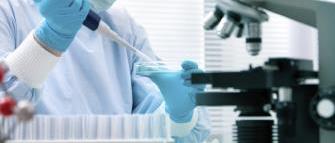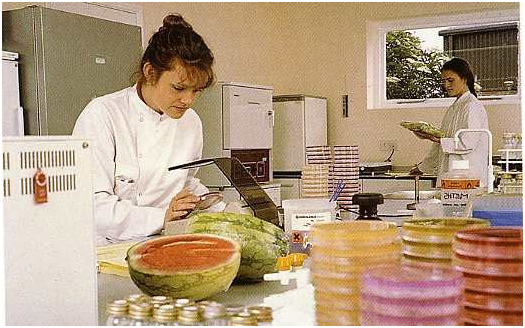Food meant for human or animal consumption should be certified safe and hygienically acceptable after production; and it is critical that food and food products undergo some series of microbiological tests including toxicological tests which test for the presence of microbial toxins in food or food products. Contaminated food and food products could serve as route through which foodborne diseases can be disseminated in a given area. And this makes food analysis a critical aspect of food microbiology.
The microbial enumeration of food is important to avoid disease outbreak due to the consumption of microbial contaminated food or food products. As aforementioned, food borne microorganisms are responsible for a number of hospital visits; and these organisms or their products are ingested by man when microbial contaminated food products are consumed. There are several reasons for microbial food analysis.
- Food is analyzed to meet certain set standards for food in any given region.
- Food is analyzed for public heath purposes especially to prevent the outbreak of foodborne diseases.
- Food is analyzed to determine the shelf-life of the food product.
- Food is analyzed to determine the quality of the food.
- Food is analyzed to determine the presence of foodborne pathogens and other contaminating or indicator organisms present in the food.
Foodborne pathogens may cause foodborne illnesses and food spoilage after the consumption or ingestion of such food or food products. Foodborne diseases usually occur either as food intoxication (in which case the infecting organism produce toxins in the food that cause diarrheal symptoms in the individual) or as food infection (in which case the foodborne pathogen is ingested and cause diarrheal sickness).
Thus microbial safety and quality of food/food products is the heart of food microbiology. Food safety and quality may be determined by the kinds and number of microorganisms that are occurring in the food. As one of the major aims of food microbiology, food microbiologists ensure food safety and quality by detecting, enumerating and identifying the microorganisms (spoilage or pathogenic microbe) occurring in the food product.
The food product or sample is usually enumerated for the presence of viable microbial cells through culture techniques, colony counts or via most probable number (MPN) of the viable cells present in the food sample. Reproduction in bacterial cell leads to the reproduction of the entire organism; and thus microbial growth can be said to be related to microbial reproduction. Knowing this fact, it is critical to enumerate bacteria in food samples in order to determine the rates of microbial growth and death in the sample.
Microbial enumeration helps us to know the number of bacteria present in the food sample; and this is usually done via culture techniques. When a pathogenic microbe is suspected, the foodborne pathogen in the food sample could be detected by the use of a more specific and differential culture media including but not limited to MacConkey agar and salmonella-shigella agar (SSA).
Serial dilutions of the food samples are inoculated onto these selective and differential media and incubated at optimal environmental conditions; and the suspect colonies are further subcultured in order to get pure cultures of the infecting organism for identification of the organism down to the species and/or strain level.
Though the microbiological assessment of food products for their quality and safety depends largely on some conventional/traditional techniques such as culture (which isolate, detect and identify spoilage and pathogenic microorganisms); it is noteworthy that there are several rapid enumeration molecular techniques such as ELISA, DNA probes and PCR that are also valuable for the prompt detection of foodborne pathogens and spoilage microorganisms present in food samples.
Traditional culture methods used for food analysis take days to weeks to complete, and they are generally too slow unlike the rapid techniques as aforementioned that are rapid to perform. In addition, the chemical and physical properties of food can make isolation of foodborne pathogens through cultural techniques difficult. Molecular techniques can detect the presence of a single, specific foodborne pathogen; and they could also detect foodborne viruses that cannot be conventionally cultured using artificial growth media. Molecular techniques such as PCR are the best for detecting slow-growing microbes in food samples as well as other non-culturable foodborne microorganisms.
Conventionally, microbial cells in a food sample can be enumerated through direct counting of cells, MPN, indirect counting of cells, viable counts, and measurement of microbial biomass. The organisms looked out for in a food sample include indicator organisms (e.g. Escherichia coli); food infection organisms and food intoxication organisms (e.g. Salmonella typhimurium, Yersinia enterocolitica, pathogenic E. coli, Clostridium botulinum, Staphylococcus aureus, Vibrio parahaemolyticus, Aspergillus flavus, Bacillus cereus, Campylobacter jejuni, Listeria monocytogenes, Clostridium perfringens and Shigella sonnei); and spoilage microorganisms (e.g. lactic acid bacteria).
These organisms are usually the most sought organisms in food sample analysis owing to the public health consequence that they portend.The microbiological quality and safety of a given food sample can be certified as Good, Acceptable, Unsatisfactory or Potentially Hazardous for human consumption; and this usually depends on certain laid down criteria upon which the microbial limits of food is certified or ascertained.
Indicator organisms are organisms whose presence in food can be an indication of poor hygiene and sanitation or inadequate processing; and these organisms (e.g. E. coli)are part of the normal microflora of the intestinal tract of animals and humans. Their presence in food also indicates feacal contamination of the food sample.
Food poisoning organisms are foodborne pathogens that must grow in food in large numbers and cause infection when consumed together with the food. Enteropathogenic E. coli (EPEC), S. typhimurium, Y. enterocolitica and V. parahaemolyticus are some examples of food poisoning organisms.
Food intoxicating organisms are microbes that cause intoxication. These organisms must grow in the food in large numbers and produce enough toxins – sufficient to cause intoxication when the food is consumed. Examples of food intoxicating organisms are S. aureus, A. flavus, and C. botulinum.
Spoilage organisms are microbes whose growth and proliferation in food creates undesirable characteristics such as change in colour, texture, odour and taste. They are considered as contaminants because they are not intentionally introduced into the food to impart certain qualities; and they generally make food unfit for human consumption.
DIRECT COUNTING OF CELLS
In this technique, cells are counted directly under the microscope. Direct counting of cells can be achieved by the use of a counting chamber and fluorescent dye. Fluorescent dyes such as acridine orange – which is known to interact with the DNA and protein components of microbial cells can be used for the direct counting of cells. Acridine orange stains both living cells and dead cells. Direct counting of cells is easier to perform but it does not discriminate between viable (living) cells and dead cells. Stained microbial cells are known to fluoresce orange when excited near ultraviolet (UV) light.
INDIRECT COUNTING OF CELLS
The two methods used in enumerating the presence of microbes in a given food sample using the indirect counting technique are the viable plate count and the most probable number (MPN) technique. Both the viable plate count and MPN give an estimate of viable cells present in the sample. In the viable plate count technique, the microbes present in a given food sample are diluted or concentrated and grown on a suitable culture media. Specifically, serial dilutions of the representative food sample containing the viable bacteria are plated out onto a suitable growth media. Plating out or culture could be performed either by the pour plate technique or by the spread plate method.
The inoculated culture media is incubated at suitable temperature for the development of microbial growth or colonies that are visible to the eyes. The number of microbes present in the original sample could be estimated by counting the number of colonies on the growth media and multiplying same with the dilution factor – since each of the microbial colony on the growth media arose from an individual cell that has undergone cell division. The number of microorganism counted is usually reported in colony forming units (CFU).
MPN is a statistical enumeration technique that is used to estimate the numbers of coliforms present in samples including food, water and milk. In MPN technique, samples are serially diluted to the point of extinction (i.e. to a point where there are no more viable microorganisms). Multiple serial dilutions of the samples are inoculated into a suitable culture medium, and the development of some recognizable microbial trait such as acid production or production of turbidity, is used to indicate microbial growth in the growth medium. The production of this microbial trait such as turbidity signals the end point of the reaction.
The presence of at least one viable microorganism in the diluted sample is indicative enough for microbial growth. The pattern of positive tests (growth) in the replicates and statistical probability tables are used to determine the concentration (most probable number) of bacteria in the original sample. Statistical MPN tables are available for replicates of 3, 5, and 10 tubes of each dilution; and the more replicate tubes used in the analysis, the greater the precision of the estimate of the size of the bacterial population.
References
Bushell M.E (1998). Application of the principles of industrial microbiology to biotechnology (ed. Wiseman, A.) Chapman and Hall, New York.
Byong H. Lee (2015). Fundamentals of Food Biotechnology. Second edition. Wiley-Blackwell, New Jersey, United States.
Clark D.P and Pazdernik N (2010). Biotechnology. First edition. Elsevier Science and Technology Books, Amsterdam, Netherlands.
Farida A.A (2012). Dairy Microbiology. First edition. Random Publications. New Delhi, India.
Frazier W.C, Westhoff D.C and Vanitha N.M (2014). Food Microbiology. Fifth edition. McGraw-Hill Education (India) Private Limited, New Delhi, India.
Guidebook for the preparation of HACCP plans (1999). Washington, DC, United States Department of Agriculture Food Safety and Inspection Service. Accessed on 20th February, 2015 from: http://www.fsis.usda.gov
Hayes P.R, Forsythe S.J (1999). Food Hygiene, Microbiology and HACCP. 3rd edition. Elsevier Science, London.
Hussaini Anthony Makun (2013). Mycotoxin and food safety in developing countries. InTech Publishers, Rijeka, Croatia. Pp. 77-100.
Jay J.M (2005). Modern Food Microbiology. Fourth edition. Chapman and Hall Inc, New York, USA.
Lightfoot N.F and Maier E.A (1998). Microbiological Analysis of Food and Water. Guidelines for Quality Assurance. Elsevier, Amsterdam.
Nduka Okafor (2007). Modern industrial microbiology and biotechnology. First edition. Science Publishers, New Hampshire, USA.
Roberts D and Greenwood M (2003). Practical Food Microbiology. Third edition. Blackwell publishing Inc, USA.
Discover more from #1 Microbiology Resource Hub
Subscribe to get the latest posts to your email.



